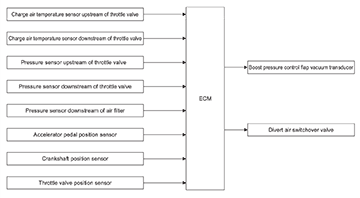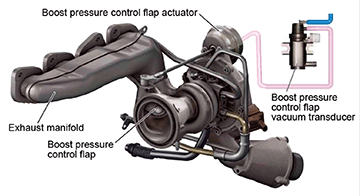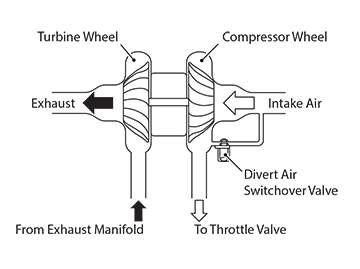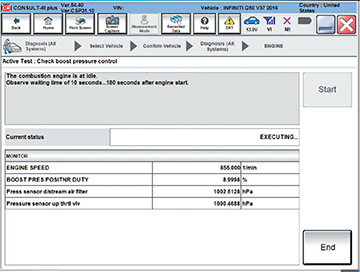CHARGE AIR CONTROL SYSTEM OVERVIEW
The charge air control system’s job is to control boost pressure to maintain an optimal boost from the turbocharger at all times.
- The system keeps the boost pressure between 80 – 120 kPa (11.6 – 17.4 psi).
- The ECM uses inputs from eight sensors to determine if boost should be increased or decreased.
- The ECM then controls the boost pressure control flap vacuum transducer, to adjust (vary) the amount of vacuum applied to the boost pressure control flap vacuum actuator (waste gate).
- When the ECM detects deceleration, the divert air switchover valve is opened to release surplus pressure upstream of the turbocharger.

CHARGE AIR CONTROL COMPONENTS CONTROLLED BY THE ECM
The ECM uses the boost pressure control vacuum transducer to apply vacuum to the vacuum actuator. When vacuum is applied, the actuator opens the pressure control flap to regulate boost pressure.
- When no vacuum is supplied from the boost pressure control vacuum transducer to the boost pressure control flap vacuum actuator, the flap (waste gate) is closed and the maximum boost is available.
- To reduce boost, the ECM operates the boost pressure control vacuum transducer, suppling a variable vacuum to the boost pressure control flap vacuum actuator.
- The more vacuum that is supplied, the more the flap (waste gate) opens. The more the flap (waste gate) opens, the more exhaust gets diverted, bypassing the turbocharger.

CHARGE AIR CONTROL DIVERT AIR SWITCHOVER VALVE
- The divert air switchover valve is normally closed, but during deceleration (throttle valve closed), the ECM detects deceleration and opens the switchover valve to release surplus pressure upstream of the turbocharger.
- When the engine is under a load again, the ECM closes the divert air switchover valve.

ACTIVE TEST
Use C-III plus to perform an active test on the divert air switchover valve to verify that it opens and closes properly.
Use You can also use C-III plus to check the boost pressure control.
